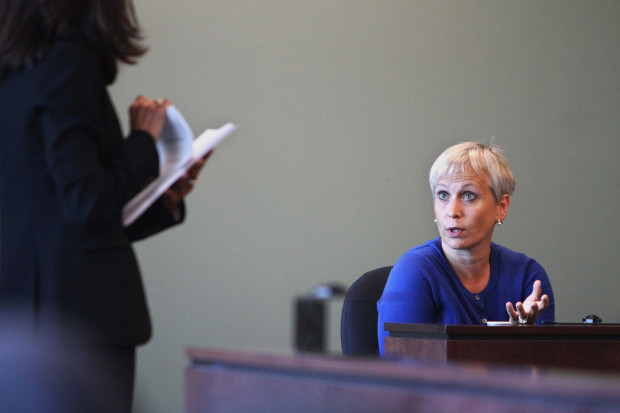LEAD ARTICLE – SEPTEMBER 2019
How Much Explanation is Too Much?
The AMA (5) Guides are both prescriptive and proscriptive. Table 17.2 is a perfect example. When assessing a lower limb impairment, there is a serious risk of measuring the same functional loss more than once. Muscle weakness and wasting are different parameters (with different impairment tables) but emanate from the same loss. Similarly, a joint with severe arthritis will invariably have restricted ranges of movement and it would be inappropriate to summate or combine both.

Orthopaedic Surgeons are skilled assessors of musculoskeletal disease. They can perform precise and accurate examinations, translate this information into a final measurement of whole person loss (or % impairment) and be relied upon to interpret the Guides appropriately. Whilst the methodology used should be open to question, with the expert being subjected to cross-examination, detailed descriptions of the processes involved do not necessarily need to be incorporated into the expert’s report to the Court.

The following text, in italics, is an example of what can be deemed “too much information”:
I have consulted the American Medical Association publication entitled “Guides to the Evaluation of Permanent Impairment”, 5th Edition (AMA 5). I have also taken into consideration the Queensland Guides to the Evaluation of Permanent Impairment, 2nd Edition (GEPI 2).
I believe that Mr X has reached a state of Maximal Medical Improvement (MMI) and can now be rated using the Guides.
Impairment can be potentially measurable through several methodologies including Gait, Atrophy, Muscle Weakness, Loss of Range of Motion, Diagnosis Based Estimates (DBE) and Peripheral Nerve Injury. Due to the indentation and unsightliness of the wound, particularly laterally, further impairment is likely to be measurable through Scarring and Disfigurement.
Based on Table 17-5 (page 529) of the AMA 5, “an individual with a major limp who requires mostly the routine use of a cane would lead to a 30% loss of whole person function”.
Based on Table 17-6 (page 530) of the AMA 5 with further modifications on page 17 of the GEPI 2, a 1cm atrophy of the calf would lead to a 6% loss of lower extremity function.
Based on Table 17-8 (page 532) of the AMA 5, a Grade I movement of the ankle in flexion, extension, inversion and eversion would lead to losses of 37%, 25%, 12% and 12% of lower extremity function respectively. Further to this, based on the same Table, a loss of great toe extension and flexion with Grade III function would lead to 7% and 12% losses of lower extremity function respectively. Combining impairments for all of these movements would lead to a 70% loss of lower extremity function.
The use of Loss of Range of Motion may be inappropriate as there is no active movement of the ankle, which is the means by which examination for Range of Motion should be undertaken according to the AMA 5 Guides. In the absence of active movement, I have had to use passive movement and this remains diminished, indicative of a true loss of range of motion. Based on Tables 17-11 and 17-12 (page 537) of the AMA 5, the losses of extension, flexion, inversion and eversion would lead to a 25% loss of lower extremity function.
Based on Table 17-33 (page 547) of the AMA 5, an intra-articular fracture with displacement would lead to a 20% loss of lower extremity function.
The most complicated methodology for assessment would involve the use of peripheral nerve injury. While the records seem to indicate intact peripheral nerves after assessment in the Emergency Department following the injury, it is apparent that this was later documented to be diminished and was mainly picked up after removal of the moon boot post-surgery. It would not be unusual for this to be iatrogenic in nature as the dissection does involve risk not only to the peroneal nerve, but also to the tibial nerve posteriorly. Further to this, application of an external fixateur is usually percutaneous and could also make nerve injury a risk. On the other hand, an accurate evaluation is also difficult pre-operatively because of the remarkable pain that Mr X would have been experiencing. Suffice to say, the difficulty in assessment with regards to peripheral nerve injury is due to the pattern of the injury, which may not specifically fall under categories in the distributions mentioned in Table 17-37 (page 552) of the AMA 5. There is certainly involvement of the common peroneal nerve as both the superficial and deep branches are involved. It seems that the involvement can range mostly from a reported 0 to 20% in terms of sensory function and motor grading would be around Grade I. I have therefore assigned a 90% involvement of this nerve.
More complex is the involvement of the loss of sensation of the plantar aspect of the foot and the absence of plantar flexion, indicative of a tibial nerve injury. While the tibial nerve is not mentioned in Table 17-37 of the AMA 5, the GEPI 2 does indicate in Section 3.33 (page 26) that the involvement of the tibial nerve can be derived by calculating a rating from the difference between the sciatic nerve rating and the peroneal nerve rating. I believe this methodology to be erroneous in that there is an assumption that the remaining impairment would also involve enervation of the hamstring muscles, which are not involved in this case. Further to this, as discussed during training for the GEPI 2, actual subtraction is not the correct methodology but rather, getting the impairment rating that when combined with the impairment for the common peroneal nerve would lead to the impairment for the sciatic nerve. Thus, the impairments are not added, but rather combined.
Based on Table 17-37, the impairment for a motor injury of the sciatic nerve would lead to a 75% loss of lower extremity function while that of the common peroneal nerve would be a 42% loss of whole person function. Using the Combined Tables Chart, a 57% loss of whole person function attributable to the posterior (tibial) nerve would lead to the appropriate impairment for the sciatic nerve when combined with the common peroneal nerve. On the other hand, the same Table indicates that there is a 17% loss of lower extremity function due to sensory injury of the sciatic nerve and the Combined Tables Chart would indicate that a 13% loss of lower extremity function applies to the tibial nerve if the common peroneal injury would lead to a 5% loss of lower extremity function.
I have isolated the motor and sensory contributions of the tibial nerve as a portion of this impairment involves the distal distribution after bifurcation of the sciatic nerve, while part of this impairment would be proximal to this and would involve enervation of the hamstring muscles. I have assigned a 40% lower extremity impairment relating to the involvement distally and a 29% lower extremity impairment relating to the involvement proximally. On the other hand, with regards to the sensory function, I have apportioned a 10% lower extremity involvement distally and a 3% loss of lower extremity function proximally. Again, I have assigned a 90% loss of function of each of these nerves. This would lead to a 38% loss of lower extremity function due to motor deficit of the common peroneal nerve and a 5% loss (rounded off) of lower extremity function due to sensory loss of the common peroneal nerve.
Further to this, for the tibial nerve a 36% loss of lower extremity function applies for the loss of motor function while a 9% loss of lower extremity function applies for the sensory loss.
Combining the lower extremity loss of function for the motor and sensory deficits of the common peroneal nerve and the distal portion of the tibial nerve would then lead to a 66% loss of lower extremity function.
Not all of the methodologies above could be used. The use of Gait is highly discouraged unless no other methodologies are available, which is not the case here. On the other hand, Atrophy would not be an applicable methodology as this would greatly underestimate the impairment and cannot be used with other methods. A choice can be made to use Muscle Weakness, which cannot be used with DBE. In this instance, it is not only the muscle that is involved but also the sensory function and since it is not truly a weakness of the muscle that is the underlying problem but rather, a dysfunction of the nerve, the use of Peripheral Nerve Injury rather than Muscle Weakness would be favoured. The peripheral nerve injury is also a separate entity to the actual injury itself, for which DBE would be the best methodology to use. While the use of Range of Motion can be considered, this would be an inappropriate methodology given that the impairment should have been measured actively and a passive means of measurement was undertaken in this instance due to the loss of power. Therefore, the methodology of choice would be to combine impairments due to DBE and Peripheral Nerve Injury.
Combining the 20% loss of lower extremity function due to the ankle fracture and the 66% lower extremity impairment due to the peripheral nerve injury would lead to a 73% loss of lower extremity function, equivalent to a 29% loss of whole person function.
Further to this, based on Table 18-2 (page 178) of the AMA 5 with further modifiers provided by the Table for Evaluation of Minor Skin Impairments (TEMSKI) in Table 14.1 (page 87) of the GEPI 2, the best fit would favour a further 2% loss of whole person function due to Scarring and Disfigurement.
Mr X would therefore suffer from a 31% loss of whole person function relating to his right lower limb injuries.

Alternatively:
A more succinct analysis could have been that the plaintiff has suffered extremely severe injuries to the affected lower limb involving skeletal, muscular and peripheral nerve losses. He has now reached a state of maximal medical improvement and can be accurately assessed according to the AMA (5) Guides. Whilst his deficits include muscle weakness and wasting, difficulties with ambulation, pain and discomfort, the need to use a cane for support and similar related maladies, he is best assessed using Table 17.33 to measure a loss of 20% of lower extremity function as a result of his fractures and a loss of 66% of lower extremity function as a result of his neural injuries. When these two losses are combined using Combined Values Tables, a loss of 74% of lower extremity function can be quantified. This equates to a loss of 29% of whole person function.
The scarring can be assessed using Chapter 8. This yields a further loss of 2% of whole person function.
The losses from Chapter 17 and Chapter 8 can be added to yield a final impairment of 31% of whole person function. This is the loss sustained by the plaintiff in the subject accident.

In Summary:
Less can be both useful and enough. By all means challenge the expert if the assessment seems incongruous or departs significantly from the norm established by other reporters. In essence though, more is not necessarily better.
